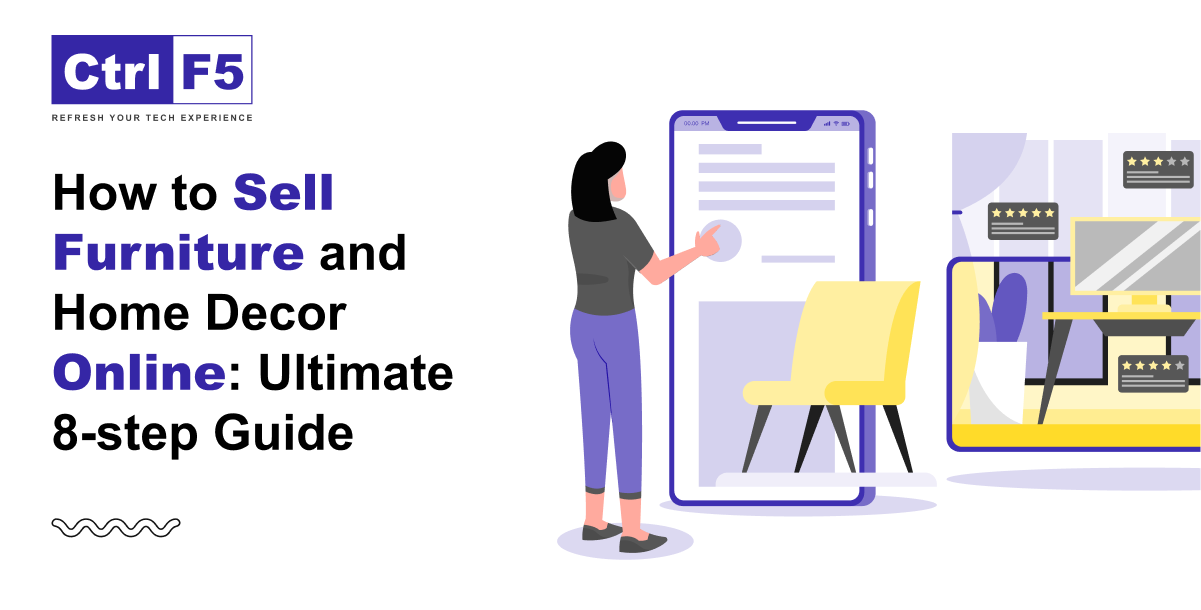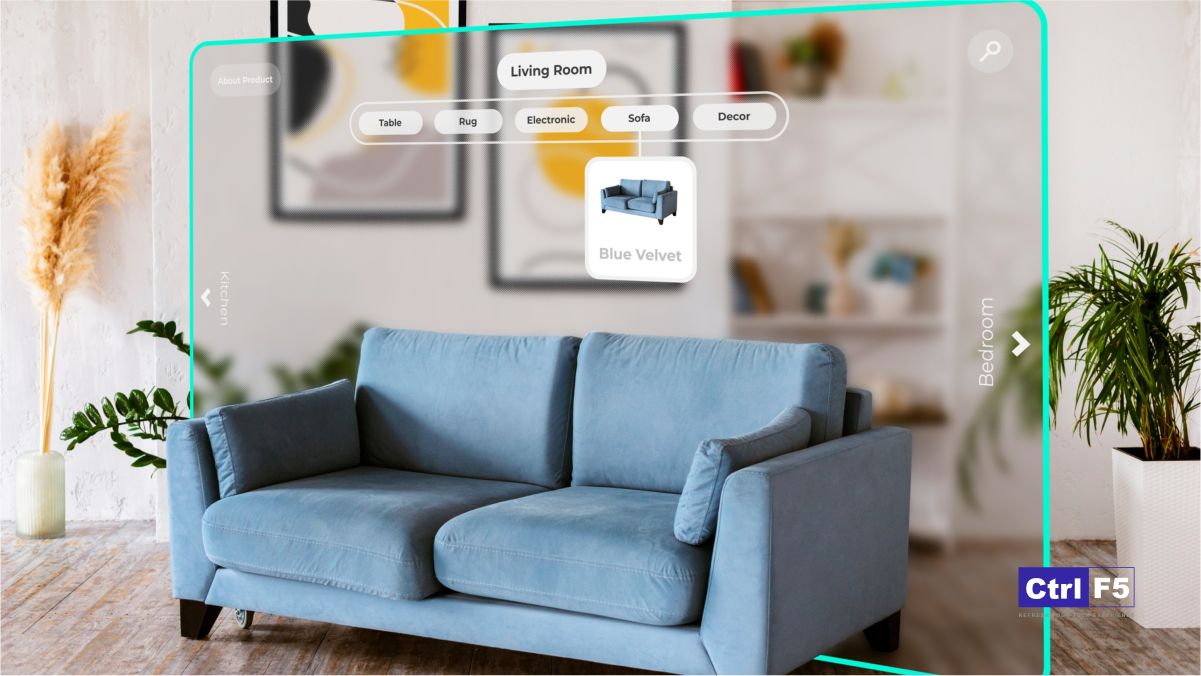How to Sell Furniture and Home Decor Online: Ultimate 8-step Guide
- Anurag Pandey
- Last updated on May 15, 2024
- eCommerce, Shopify, Shopify Plus, Woocommerce
- 11 minutes read
Table of Contents
ToggleJust like food and eCommerce, the growth of the furniture business is powered by a constant demand. Furniture that we utilise on a daily basis has form and functionality while also displaying our style and individuality.
Whether you are setting up a new home or office or just changing a few accessories to add character to your four-walled space, these pieces of wood, glass, metal, and plastic help you make the place a little more comfy, a little bit more personal and a lot more your very own.
And it is true that there is no one who doesn’t like to have a cosy corner to sit, think, relax or just work on that dream project!
That is why knowing how to sell furniture online is a fantastic business opportunity. Many people purchase furniture online—it’s estimated according to statista that furniture and home furnishings sales account for 12.3% of all US ecommerce sales.
Today, technology has enabled the online rendering of the in-person experience, covering the path for even more furniture businesses—and more choices. With the increasing urbanization and expanding trend of modular and cutting-edge home decor and fittings, the furniture sector has emerged as one of the most sought-after online business endeavors by entrepreneurs. Whether you already have an offline home decor business or are considering launching a new online endeavor, now is the time to dive in on how to sell furniture online and create an online store to give your company a competitive advantage.
And do you want to know how you can do that?
Then you are at the right place, kindly look over our writing to understand how to sell furniture online and start a successful eCommerce business.
How to Sell Furniture and Home Decor Online: Top 8 Steps
There is a lot of competition in the furniture and home decor business, especially when you consider the massive presence of low-cost global chains. That’s why it’s critical to distinguish your items, identify your unique selling scheme, and create a memorable brand.
Let’s go over the initial stages of Selling Home Decor Online:
- Choose your business model
- Finance your furniture business
- Build your online furniture brand
- Set up shop (for furniture makers)
- Setting Up Your Online Store
- Creating a social media persona
- Shipping, Returns, And Customer Service
- Choosing an online payment gateway
1. Choose your business model
- Furniture maker
To begin with, how to sell furniture and home decor online, you have to start with this form of company that entails designing and hand-building furniture in your workshop. You can choose to build and sell a restricted number of styles by stocking inventory or using a made-to-order model. Alternatively, you may provide a custom service that allows your customers to specify precise dimensions and features. A furniture maker firm necessitates technical knowledge, specialized tools, and a dedicated workshop area.
- Furniture designer (working with a manufacturer)
Rather than making the furniture yourself, you can design it and have a builder or manufacturer create the pieces for you. To effectively connect with factories, you may need some specialized drafting abilities as well as an understanding of materials and construction.
- Keeper and vendor
You would sell a variety of things from many companies or creators in this approach, ranging from collections that are distinctive to your brand. While you are not inventing and manufacturing the objects, there is a need for creativity in developing a unified brand and selling home decor online products through storytelling, photography, and customer experience. In this situation, you would buy things wholesale from other brands and ship them to clients directly.
- Dropshipper
This method is similar to the one described above, but it provides a hands-off option if you are unable to store or send the products yourself. Look for manufacturers and companies who are prepared to ship straight to your clients, removing you from the supply chain.
- Vintage dealer
This is yet another keeper/reseller approach that concentrates on unique vintage or antique items. We’ve separated this out because the ways of sourcing it are different. To determine which pieces have resale value and which are in demand, you’ll need to be familiar with the vintage market. To be able to restore vintage finds, it’s also helpful to have abilities in furniture repair and refinishing. Generally, vintage and antique furniture dealers will require a significant amount of space for inventory, unless you opt for a shipment model.
2. Finance your furniture business
How much does it cost to start a business selling home decor online? Well, that answer depends on what business model you choose.
In the home decor business, how to sell furniture online will be a top question if you plan to dropship, you can get started with a few hundred dollars on the low end because there is no need to keep inventory. If you already have a hobby workshop, a custom/made-to-order furniture business can have modest startup costs. This concept allows you to acquire supplies as you go, eliminating the need for a large upfront investment.
On the higher end, expect to invest tens of thousands of dollars to set up a workshop if you don’t already own the essential tools and equipment to start a maker business. Consider the expense of renting space (if applicable), utilities, and safety equipment (such as sufficient ventilation). Starting a resale business can also be pricey, as you will need to purchase or hold an inventory.
3. Build your online furniture brand
It is critical to define your brand at this early stage. Answering a few questions can help you communicate your brand’s story, define your visual identity, sum up your mission, and visualize your ideal consumer more clearly.
Choose a lane for your furniture business now that you’ve selected whether to make or resale furniture.
- Will you only sell sofas and focus on a single product?
- Do you want to get in on a hot trend?
- Do you intend to concentrate on well-crafted minimalist pieces for tiny spaces?
- What about capitalising on the growing number of people working from home and offering one-of-a-kind office furniture?
Consider the following (with examples) while going for a brand:
- Category/use: Office furniture, outdoor living, home accents
- Product: Sofa beds, dining tables, nursery items
- Style: Mid-century modern, minimal, rustic
- Customer: Students, apartment dwellers, cottage owners
- Niche: “Smart” furniture, modular pieces, furniture made from recycled materials
- Cause: Fair trade, handmade locally, sustainable
- Price: Low retail/high volume, high-end/bespoke
4. Set up shop (for furniture makers)
If you don’t already own tools or have a specialised workshop, starting as a furniture manufacturer might be costly. You can begin with the fundamentals and gradually expand your toolset as your company expands.
Here is some expert advice on how to start your own furniture workshop:
- Maintain a clean workshop: A safe and productive shop is one that is clean and well-organized.
- Consider the following workflow: What tools are you going to need to get the job done? In what order will they be applied? This will assist you in determining the arrangement for each major piece of machinery. You simply find the finest location for the smaller items from there.
- The table saw is the beating heart of your shop: Make sure you have adequate room around it to make the necessary cuts.
- Turn it on: When it comes to lighting, go greater than you think you need. There is never enough light in the shop! Some pros advise using LEDs everywhere.
5. Setting Up Your Online Store
Setting up your products online may carry many important steps like:
- Decide on your branding and secure your domain name. You can purchase your domain name through a domain registrar like GoDaddy Bluehost or Hostinger. If you are unable to get the domain, you may be unable to proceed with your business name.
If you are unable to obtain the.com version, consider the. shop or .store domain extensions. When you’ve secured your domain, make sure all branding, such as the logo, is consistent with the company and domain name. - Choose the best hosting service. Every website must be saved somewhere.
The manner in which they are stored or hosted can have an impact on the site’s dependability and speed. Your domain purchase may have included website hosting; however, it may need to be upgraded. - Always opt for a great ecommerce platform for you. Do your homework. Consider how much technical skill is required, the prices charged, the features you require the most, and so on.
- Whether you want to sell in a B2B or B2C commerce platform you have to decide on a payment service provider. Payment solutions are embedded into eCommerce website platforms like
- Shopify,
- Wix,
- WooCommerce,
- Salesforce Commerce Cloud Services and
- BigCommerce
These are a few great options for businesses and individuals. If, on the other hand, the online store is developed on a more configurable platform, such as Magento, a payment solution, such as Paypal will be required. An Internet Merchant Bank account may be necessary as well. These are available from most high-street banks.
6. Creating a social media persona
Social media has progressed far beyond simply improving brand exposure. According to a recent survey, most of the Indian customers are purchasing things over social media.
Creating visual experiences on networks like Facebook or Instagram might help you expand your online catalog. You’ll have the ultimate conversion post if you include personalised hashtags and CTAs in your captions. By including a store link in your social media posts, you can directly connect your audience to your selling home decor online store.
Brands can also benefit from social media marketing by engaging with their audiences on a regular basis and encouraging user-generated content. Not only that, but You can also motivate or educate your audience by giving your brand’s story or decorating ideas.
7. Shipping, Returns, And Customer Service
Shipping on your own can appear to be a daunting task. This is why some furniture companies prefer to outsource inventory management, fulfillment, and shipment to warehouse partners.
However, if you’re just getting started, you may have to handle order fulfillment and shipping yourself. These few pointers may come in handy while shipping products:
- Find a shipping business with a strong reputation and establish a relationship with them. Check ahead of time to see if you can get quick rates based on weight and dimensions so you can incorporate that into your price. You don’t want to be surprised with a shipping bill, and neither does your consumer.
- Make sure to properly package or box your merchandise. In this manner, you can rest assured that your lovely dining table will look exactly as it should when it reaches your customer.
When dealing with big things, returns can be quite difficult. Make sure your return policy is crystal clear. If you do not accept returns, make this obvious to the customer during the checkout process and even on the product page. If you are ready to accept returns, set the terms with your shipping partner ahead of time and inform the consumer who will be responsible for the return shipping charges, which may be significant.
8. Choosing an online payment gateway
Accepting payments through your online store will necessitate the use of a payment gateway that is simply accessible and available to your target audience. Some payment gateways enable you to integrate eCommerce platforms to simplify the transaction process.
Here are some aspects to consider when selecting a payment gateway for your online furniture store:
- Provide numerous currencies and payment ways for the convenience of your consumers. You can accept payments using debit or credit cards, net banking, or digital wallets such as Amazon Pay, Shopify Payment, and Google Pay. You can also enable third-party payment providers on your favorite marketplace or allow your clients to pay cash on delivery.
- Make certain that the checkout procedure is mobile-friendly.
- Choose a PCI DSS-compliant payment provider that guarantees secure transactions and does not ask customers to register for their services.
- To address any payment difficulties, the payment provider must provide 24-hour customer care.
Consider the costs associated with selecting a gateway, from the setup charge to transaction or monthly fees. Payment providers’ holding periods and transaction restrictions may also differ.
There’s no place like home: Last Thoughts
As one of the great writers once said, “The design of a dress, furniture, a house, a room, a street, and a city are all the same process.”
Now that you know How to Sell Furniture online, then it’s time to get started! To stay ahead of the competition and create a profitable home decor business online, take your first step today towards pursuing your passion, by choosing the ControlF5 team that will make it simple to market your online store.
Contact us to start your dream eCommerce store and manage it easily!
Anurag Pandey
Recent Posts
Categories
Hire Developers
About us
Popular Posts
Tags
Related Articles

10 Dropshipping Shopify Apps for Shopify Stores 2024
Dropshipping is not an easy business to get started; it requires time, strategy, and a proper way of operation. However, identifying how to choose dropshipping apps for the shopify store and using the proper tools helps to develop a successful dropshipping business.

Best Dropshipping Suppliers For Shopify Stores in 2024
Are you looking for how to find the best dropshipping suppliers for shopify? Then this piece of content is especially for you…!
Dropshipping is a wonderful way for future eCommerce entrepreneurs to scale their businesses.
How to Use Upsell: 10 Techniques to Boost Your Sales
Ah, the upsell—the salesperson’s best friend. When done correctly, it can also be very popular with clients. Many businesses use ads, emails, seasonal deals, and coupon codes to drive traffic and acquire new consumers. However, many ecommerce store owners overlook the need to raise the average order value.
Sign up for our Newsletter












